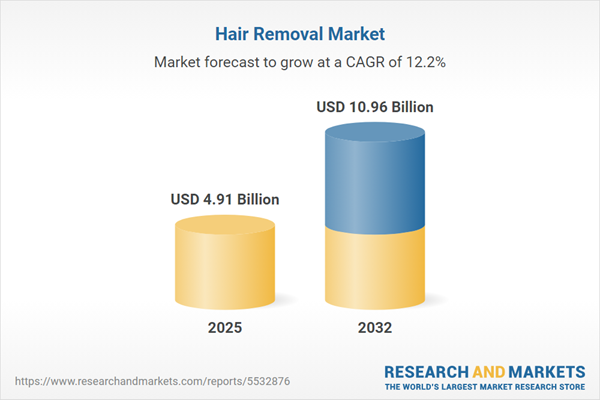Speak directly to the analyst to clarify any post sales queries you may have.
The hair removal market is undergoing substantial transformation, driven by shifts in consumer preferences, advances in technology, and evolving global regulatory dynamics. This dedicated report distills actionable intelligence for senior decision-makers seeking to optimize strategies within this competitive landscape.
Market Snapshot: Hair Removal Market Size and Growth Trajectory
The hair removal market grew from USD 4.37 billion in 2024 to USD 4.91 billion in 2025, with a projected compound annual growth rate (CAGR) of 12.16%, reaching USD 10.96 billion by 2032. Expansion is propelled by heightened consumer interest in both advanced at-home solutions and clinic-based treatments, spanning key geographies and diverse demographic segments.
Scope & Segmentation
This report offers a comprehensive view of the competitive and technological landscape, providing segmentation by category, procedure, channel, end user, and region.
- Product Types: Depilatory creams, electrolysis (home and professional), epilators (home and professional), laser and IPL devices (clinic-based and home use), shaving (electric shavers, manual razors), waxing (hard wax, pre-waxed strips, soft wax).
- Procedure Types: Permanent hair reduction, temporary hair removal.
- Distribution Channels: Hypermarkets and supermarkets, online retail (brand websites, e-commerce platforms, social commerce), pharmacies and drug stores, salons and clinics, specialty stores.
- End Users: Home use, professional use in aesthetic clinics, beauty salons, dermatology clinics, medical spas.
- Regional Coverage: Americas (North America, Latin America), Europe, Middle East & Africa, Asia-Pacific (including major economies and emerging markets).
- Technology Landscape: Adoption of laser, intense pulsed light, improved depilatory formulations, and device miniaturization.
Key Takeaways for Senior Decision-Makers
- Omnichannel strategies are essential as social commerce and direct brand websites complement traditional retail distribution, enabling broader market reach and tailored consumer experiences.
- Rising demand for personalized recommendations and sustainable, cruelty-free formulations indicates a strategic shift toward data-driven platforms and eco-responsible supply chain management.
- The integration of at-home devices is reducing reliance on professionals for basic hair removal, necessitating hybrid models and partnerships between manufacturers and service providers targeting both incremental and definitive solutions.
- Regional markets exhibit unique regulatory requirements and consumer expectations, prompting brands to innovate with localized product adaptations and adaptive compliance roadmaps.
- Stakeholders must prioritize product safety, transparent ingredients, and alignment with environmental regulations to maintain and grow consumer trust in a highly competitive environment.
Tariff Impact and Supply Chain Dynamics
Imminent United States tariff adjustments for 2025 will require proactive planning for sourcing, procurement, and inventory management, especially for manufacturers reliant on imported components and consumables. Companies exploring modular product designs and alternate suppliers can minimize exposure. Ongoing trade negotiations could bring further complexity, compelling supply chain directors to develop agile contingency plans and deepen partnerships across logistics networks.
Methodology & Data Sources
This report leverages a robust research methodology combining comprehensive secondary data review, direct interviews with industry and clinical stakeholders, and workshops for validation. Quantitative findings are anchored by sales data and validated through expert perspectives, ensuring reliability and strategic relevance.
Why This Report Matters
- Offers clarity on evolving consumer and technological trends crucial for strategic positioning in the hair removal market.
- Empowers executives to mitigate regulatory and supply chain risks while capitalizing on regional opportunities and hybrid business models.
- Supports investment decisions with precise, actionable segmentation, competitive benchmarking, and forward-looking insights.
Conclusion
Senior leaders equipped with this analysis can confidently navigate the hair removal market’s changing terrain, anticipating regulatory, channel, and consumer shifts. Proactive adaptation—grounded in data and industry collaboration—will drive sustainable growth in the years ahead.
Additional Product Information:
- Purchase of this report includes 1 year online access with quarterly updates.
- This report can be updated on request. Please contact our Customer Experience team using the Ask a Question widget on our website.
Table of Contents
3. Executive Summary
4. Market Overview
7. Cumulative Impact of Artificial Intelligence 2025
Companies Mentioned
The companies profiled in this Hair Removal market report include:- The Procter & Gamble Company
- Edgewell Personal Care Company
- Reckitt Benckiser Group plc
- Coty Inc.
- Hologic, Inc.
- Koninklijke Philips N.V.
- Lumenis Ltd.
- Sisram Medical Ltd.
- Bausch Health Companies Inc.
- Tria Beauty, Inc.
Table Information
| Report Attribute | Details |
|---|---|
| No. of Pages | 182 |
| Published | October 2025 |
| Forecast Period | 2025 - 2032 |
| Estimated Market Value ( USD | $ 4.91 Billion |
| Forecasted Market Value ( USD | $ 10.96 Billion |
| Compound Annual Growth Rate | 12.1% |
| Regions Covered | Global |
| No. of Companies Mentioned | 11 |









